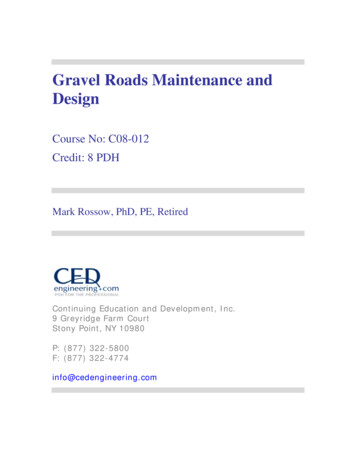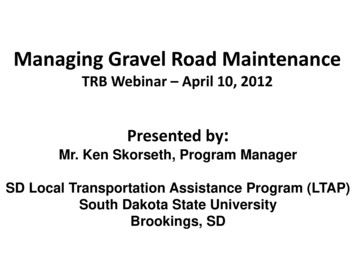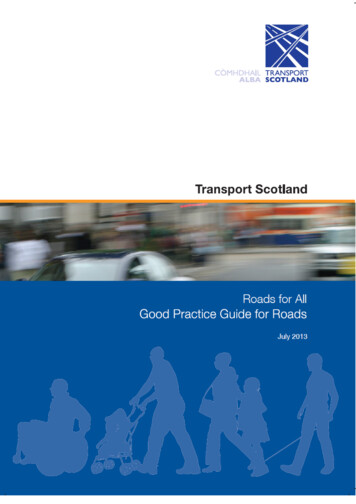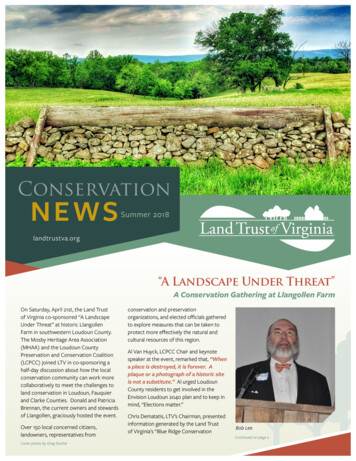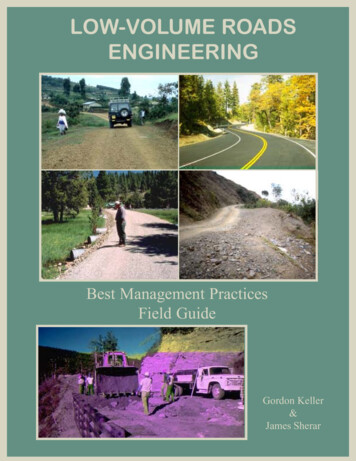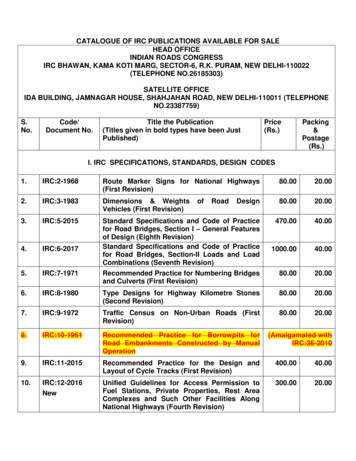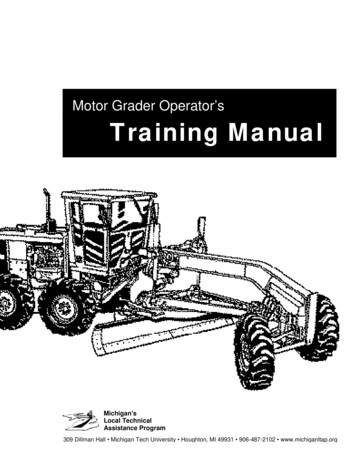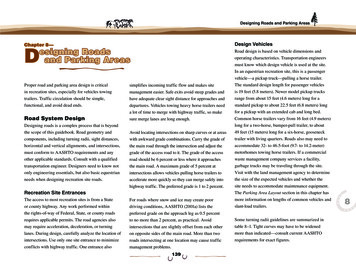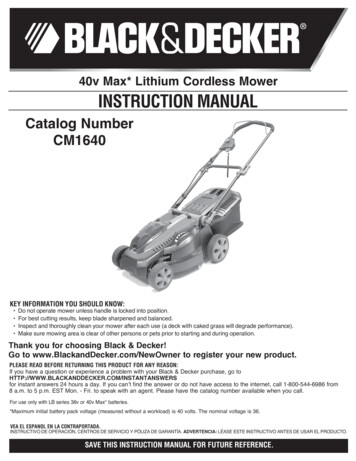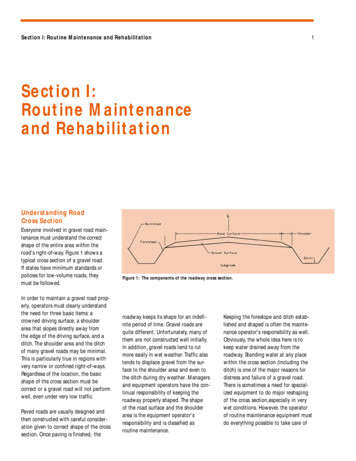
Transcription
Section I: Routine Maintenance and Rehabilitation1Section I:Routine Maintenanceand RehabilitationUnderstanding RoadCross SectionEveryone involved in gravel road maintenance must understand the correctshape of the entire area within theroad’s right-of-way. Figure 1 shows atypical cross section of a gravel road.If states have minimum standards orpolicies for low-volume roads, theymust be followed.In order to maintain a gravel road properly, operators must clearly understandthe need for three basic items: acrowned driving surface, a shoulderarea that slopes directly away fromthe edge of the driving surface, and aditch. The shoulder area and the ditchof many gravel roads may be minimal.This is particularly true in regions withvery narrow or confined right-of-ways.Regardless of the location, the basicshape of the cross section must becorrect or a gravel road will not performwell, even under very low traffic.Paved roads are usually designed andthen constructed with careful consideration given to correct shape of the crosssection. Once paving is finished, theFigure 1: The components of the roadway cross section.roadway keeps its shape for an indefinite period of time. Gravel roads arequite different. Unfortunately, many ofthem are not constructed well initially.In addition, gravel roads tend to rutmore easily in wet weather. Traffic alsotends to displace gravel from the surface to the shoulder area and even tothe ditch during dry weather. Managersand equipment operators have the continual responsibility of keeping theroadway properly shaped. The shapeof the road surface and the shoulderarea is the equipment operator’sresponsibility and is classified asroutine maintenance.Keeping the foreslope and ditch established and shaped is often the maintenance operator’s responsibility as well.Obviously, the whole idea here is tokeep water drained away from theroadway. Standing water at any placewithin the cross section (including theditch) is one of the major reasons fordistress and failure of a gravel road.There is sometimes a need for specialized equipment to do major reshapingof the cross section,especially in verywet conditions. However, the operatorof routine maintenance equipment mustdo everything possible to take care of
2Understanding Road Cross SectionThis road, located in Poland, has very poor cross section with noditches. Consequently, water drains down the roadway itself andafter many years of erosion,the roadway is several feet lowerthan its original elevation. (Courtesy of Mary O’Neill,Office ofRemote Sensing, South Dakota State University)This well-traveled road in Ecuador performswell in a region that receives approximately200 inches average annual rainfall.(Courtesy of Ron Anderson, TensarEarth Technologies, Inc.,USA)
Understanding Road Cross Section3the roadway since budgets often do notallow for the use of extra equipmentand manpower on gravel roads.The recommended shape of each partof the cross section will be discussed indetail later in this manual.When agravel road is maintained properly, itwill serve low volume traffic well.Unfortunately, most gravel roads willfail when exposed to heavy hauls evenwhen shaped properly. This is due toweak subgrade strength and marginalgravel depths which are often problemswith gravel roads. The low volume ofnormal traffic does not warrant reconstruction to a higher standard. However,improper maintenance can also leadto very quick deterioration of a gravelroad, especially in wet weather. Themaintenance equipment operators mustalways work at maintaining the propercrown and shape.Example of a gravel road with good shape of cross section. Notice crown in driving surface andproper shape of shoulder and ditch.An example of a well shaped gravel road shoulder that slopes away from the driving surfaceand drains water to the inslope and ditch.
4Routine Shaping PrinciplesRoutine Shaping PrinciplesThe distortion that was cut into this roadsurface is the result of operating a motorgradertoo fast.The angle of the depressions whichmatch the angle of the moldboard reveal this.This is not the same as “washboarding,” whichhas different causes.Grader operator cleaning a ditch and restoringshape to the foreslope and backslope.he primary focus of this sectionwill be the use of the motorgraderfor gravel road maintenance. However,there are other devices used for thejob that can work well. Front or rearmounted grading attachments fortractors, road rakes, and other devicesof various designs are used in someareas of the country. The principles ofshaping are the same no matter whatmachine is used.TOperating SpeedOperating speed in blading operationsmust not be excessive. This has causedproblems on many roads. It is virtuallyimpossible to do good work above atop speed of 3 to 5 mph.When themachine begins to “lope” or bounce,it will cut depressions and leave ridgesin the road surface. Conditions includingmoisture, material, and subgrade stability vary; therefore, the maximum speedfor good maintenance can vary.However, in virtually any condition, it isdifficult to exceed 5 mph and still do agood job.Moldboard AngleThe angle of the moldboard is also critical to good maintenance. This angle isfixed on some grading devices, but onmotorgraders it can be easily adjusted.It is important to keep the angle somewhere between 30 and 45 degrees. It isa challenge to recover loose aggregate
Routine Shaping Principles5This is an example of poor use of the grader.The moldboard is pitched back too far and isnot angled enough.Notice the gravel builds upand does not fall forward to give a good mixingaction.Also, the loss of material from the toeof the moldboard will create a high shoulder,which destroys good drainage across theshoulder to the ditch.Moldboard pitch or “tilt” refers to how much themoldboard is tipped forward or backward.Theright pitch ranges from aggressive cutting (1), tospreading (2),to light blading or dragging action(3) for maintenance of gravel roads.12This is the other extreme of pitching themoldboard too far forward.The material will notroll across the face of the moldboard and doesnot mix.In addition to this, the cutting edge willnot easily penetrate a hard surface, making ithard to trim out even light depressions in theroad surface. It simply tends to skip along thesurface with no real benefit.3
6Routine Shaping PrinciplesNotice these examples of good pitch and angle. The gravelfalls forward and moves across the moldboard very well.The cutting edge is close to vertical from the road surface,which makes a nice light trimming action for routinemaintenance, and the angle is good,not allowingmaterial to spill from the toe of the moldboard.from the shoulder of the roadway without spilling material around the leadingedge (toe) of the moldboard. Operatingwithout enough angle is a primarycause of this spilling.Moldboard PitchAlong with correct angle, it is importantto understand proper pitch or “tilt” of amoldboard. If the moldboard is pitchedback too far, the material will tend tobuild up in front of the moldboard andwill not fall forward and move along tothe discharge end of the blade. This alsocauses excess material loss from the toeof the moldboard.It also reduces themixing action that is desirable whenrecovering material from the shoulderand moving it across the roadway, leveling and smoothing it in the process. Thismixing action is part of routine maintenance. Traffic tends to loosen materialfrom the road surface and displace it tothe shoulder area as well as betweenthe wheel tracks. The stone will tend toseparate from the sand and the finesized material.At the same time, smallpotholes and an uneven surface willdevelop. It is the job of the maintenanceoperator to recover the material, mix itagain as it rolls along the face of themoldboard and restore good surfaceshape.
Routine Shaping Principles7Figure 2:Illustration of an articulated motorgrader. (An illustration showing additional components of a motorgrader andrecommended walk-around checks is shown in Appendix E.)Motorgrader StabilityIt can sometimes be hard to keep amachine stable, especially while carrying a light load of material. Counteracting machine bounce or “loping”requires experience in knowing thecause and then finding a solution.Ifa motorgrader begins to rock from sideto side — often called “duck walking”in the field — it is usually caused byblade angle that closely matches theangle from corner to corner of the tireson the rear tandems. The solution isgenerally to stop, change angle slightlyon the moldboard and slowly resumeblading. Simply reducing speed willoften eliminate the loping effect of amachine. Experimenting with differenttire inflation pressures can also helpstabilize a machine as well as leaningthe front wheels in the direction thatmaterial is being moved. Filling tireswith liquid ballast to about 70%capacity is sometimes done to increasetraction, weight and stability of thegrader. The ballast often used is asolution of calcium chloride and water.Stability problems that are constant andsevere should be brought to the attention of your equipment dealer and/ortire supplier.ArticulationVirtually all modern motorgraders areequipped with frame articulation. It canbe an advantage to slightly articulatethe machine to stabilize it even in acommon maintenance operation.
8Routine Shaping PrinciplesWindrowsIn some areas of the country, particularly arid or semiarid regions, it is commonto leave a small maintenance windrow,sometimes referred to as an inventorywindrow. This leaves a small amount ofmaterial to be picked up next time andworked back across the road for fillingsmall depressions. This is a commonlyIf a maintenance windrow is allowedby policy and used, try to keep it aslight as possible. These examplesshow a light windrow being placedat the edge of the roadway and anobviously excessive windrow beingleft at the roadside. In the latter case,multiple passes should have beenmade to work out the vegetationand spread more of the materialon the roadway, or perhaps somemechanical means of breaking upthe lumps of sod such as a diskshould have been used to allowmore of the material to bespread on the roadway.accepted practice in some regions. Inothers, it is disapproved of and departments may even have policies forbidding windrows. This is often true inregions with narrow right-of-ways andnarrow driving surfaces. Operatorsshould follow department policy at alltimes. For those who allow the use ofwindrows, it is very important to keepthem to a minimum. It can be very diffi-cult to define what is acceptable andwhat is an excessive windrow. Thewindrow should also be placed near theedge of the roadway to allow as greata width for travel as possible. In theabsence of a policy on this matter, beaware of the commonly accepted prac tices in your region and try to deviateas little as possible.
Crown9Crownstablishing proper crown in thegravel surface probably generatesmore controversy than any other aspectof good maintenance. How much crownis enough? Can one get too much?What is a recommended crown? Theseare frequently asked questions by localofficials, the traveling public, and equipment operators.EFirst of all,problems develop quicklywhen a gravel road has no crown.Water will quickly collect on the roadsurface during a rain and will soften thecrust. This will lead to rutting which canbecome severe if the subgrade alsobegins to soften. Even if the subgraderemains firm, traffic will quickly poundout smaller depressions in the roadwhere water collects and the road willdevelop potholes. A properly drainedgravel road should have crown.A road that lacks good crown.There is also centerline corrugation (washboarding),a problemthat will grow worse when there is inadequate crown.Yet an operator can also build too muchcrown into the road surface. This canlead to an unsafe condition in whichthe driving public does not feel comfortable staying “in their lane”or simplystaying on the right side of the road.Because of the excessive crown,driversbegin to feel a slight loss of control ofthe vehicle as it wants to slide towardsthe shoulder. There is additional riskdriving on gravel roads with excessivecrown in regions that experience snowand ice cover. For these reasons driverswill tend to drive right down the middleof the road regardless of how wide it is.A gravel road with a 26-foot driving surface, yet everyone drives in the middle. The primary reason is excessive crown.
10CrownWhat then is recommended crown?Recommendations from supervisorsand skilled operators across the countryindicate that at least 1/2 inch of crownper foot (approximately 4%) on thecross slope is ideal. It is also recognizedthat it is virtually impossible for anyoperator to maintain an absolutelyuniform crown. However, try to deviateas little as possible. There are crowngauges available which can be used todetermine existing crown. There arealso very sophisticated electronic slopecontrols available for graders. Theseare found more often in constructionoperations than in maintenance, butcertainly can be used for maintenance.This road located in New Zealand does not have adequate crown to drain water to the roadside.Consequently, potholes form. (Courtesy of Ken Skorseth,SD LTAP)Problems from center wear in cutting edge.There is one further problem withcrown that needs to be discussed.The ideal shape is a straight line fromthe shoulder up to the centerline ofthe road. This gives the road the sameshape as the roof of a house, oftenreferred to as a flat “A” shape. However,this shape can sometimes becomerounded. The engineering term for thisis “parabolic crown.” This is virtuallyalways a problem. The middle portionof the road will have considerably lesscrown than the outer edges. Water willnot drain from the middle and potholesand ruts will form. The greatest causeof parabolic crown is excess wear atthe center of the cutting edge. This isnormal wear and will vary with typesof gravel, width of road, wheel pathlocation and other factors. A goodoperator will make an effort to avoidthe parabolic shape on a roadway bykeeping the cutting edge straight.
CrownRoadway with parabolic crown.The outer edge of the road slopes too much. Gouging causeshigh shoulder, and center 1/3 of the road tends to be flat.11A simple method is to use a cuttingtorch and straighten the cutting edgewhenever 1/2 to 3/4 inch or more ofcenter wear exists. Another methodis to use a thicker, harder section ofcutting edge in the middle of themoldboard to resist wear. This willretard excess center wear, butgenerally will not eliminate it.Another option is to use the moderncarbide-tipped bits on the cuttingedge. These are extremely wearresistant and dramatically reducecenter wear. There are also carbideinsert or carbide-faced cutting edgesthat are very wear-resistant.In summary, the recommendedcrown is a straight line from theshoulder to the centerline that risesapproximately 1/ 2 inch per foot(or approximately 4%).This road in New Zealand performs remarkably well because of good crown and good gravelquality in a region that receives nearly 150 inches of moisture a year! (Courtesy of Ken Skorseth,SD LTAP)
12Road ShoulderRoad Shoulderhe road shoulder serves severalessential functions. It is there tosupport the edge of the traveled portionof the roadway. But another importantfunction is to provide a safety area fordrivers to regain control of vehicles ifforced to leave the road surface. Yetanother important function is to carrywater further away from the roadsurface to the foreslope and ditch.TIn order for the shoulder to performall of these functions, its shape iscritical. First of all, the shoulder shouldmeet the edge of the roadway at thesame elevation. In other words, theshoulder should be no higher or nolower than the edge of the roadway.By maintaining this shape, the lowshoulder or drop-off is eliminatedwhich is a safety hazard and alsoreduces roadway edge support.But the other extreme, which is ahigh shoulder, should also be avoided.This will be discussed later.It is also recognized that gravel roadsin some regions, particularly those withvery narrow right-of-ways, have verylittle shoulder area. In some cases, theedge of roadway is actually the beginning of the foreslope down to the ditch.But here again, it is important thatthere is not a steep drop-off or a ridgeof soil to block drainage. Maintainingshoulders is a critical part of gravelroad maintenance.The photos above and below show good examples of gravel shoulders that match the edge ofthe roadway very well and drain water to the ditch.
Road Shoulder13A common condition along the edge of manygravel roads:the secondary ditch.High Shoulders(Secondary Ditches)This problem can be seen alonggravel roads almost anywherepeople travel. There are many slangterms used in the field such as “berms”or “curbs.” The engineering term forthis condition is “secondary ditch” andit is a good description of the condition.When a gravel road develops a highshoulder, it destroys the drainage ofwater directly from the surface to thereal ditch. This causes several problems.In relatively level terrain,the watercollects here and seeps into the subgrade, often causing the whole roadwayto soften. In rolling and rugged terrain,the water quickly flows downhill alongthe secondary ditch,often eroding awaya large amount of gravel and evenSecondary ditch over six inches deep.eroding into the subgrade. This alsocreates a serious safety hazard. Thereare many reasons to work hard toeliminate secondary ditches.
14Road ShoulderCauses of High ShouldersWhat causes secondary ditches to form?There are several causes. They candevelop from improper maintenancesuch as losing material from the toe ofa grader’s moldboard,which builds up ahigh shoulder, or from cutting too deepat the shoulder line with the toe of themoldboard. This is a particular problemwhen the cutting edge is not keptreasonably straight. But there are othercauses, such as excessive “whip-off” ofloose material from fast traffic,whichtends to build up along the shoulderline. Also, heavy loads on gravel roadswith weak subgrades can cause this.When heavy vehicles have to travelnear the shoulder while meeting othervehicles, the roadway can rut whilethe shoulder area shoves upward. Yetanother cause is the buildup of sand innorthern regions where winter ice/snowcontrol requires some winter sandingoperations on gravel roads. An expertin the field once made this statement:“It is difficult to completely eliminatesecondary ditches, but it pays to workhard to keep them to an absoluteminimum.” This is excellent advice.The time spent in dealing with a highshoulder (secondary ditch) will resultin a road that is easier to maintainafterwards. But the real challenge isgetting the job done.vegetation on the shoulder, simplyextend the moldboard out into theshoulder material and begin to pull itonto the roadway. If the amount ofmaterial is light, you may be able to dothis in one pass. The material recoveredis often good gravel that needs to bereturned to the roadway surface.Here, water has run down a secondary ditchor high shoulder and then eroded throughthe shoulder material at the bottom of a hill.This creates a hazardous condition.Recovering andSpreading on RoadwayIf a motorgrader is the only piece ofequipment used on the job, generallymore than one pass will be required torecover material from high shoulders.It is wise to place standard MUTCDwarning signs such as “Road WorkAhead” since this is more than routinemaintenance. If there is little or noUsing grader to recover material from a highshoulder and restore correct shape to theshoulder.
Road Shoulder15Breaking up Sodand Vegetation inRecovered MaterialQuite often, the material pulled outonto the roadway from the shoulder isvery hard to spread because of the vegetative material in it. It will require multiple passes with the grader to get thejob done. Many agencies are turning toother mechanical means of breaking upthe material to make the road safe fortraffic. This can range from somethingas simple as a disk or drag to sophisticated pulverizing equipment.Windrow pulverizer fabricatedby the Hyde County HighwayDepartment of Highmore,South Dakota.A commercially manufactured pulverizer.A small rear-mounted tandem disk on a mower tractor.A commercially manufactured rock rake,normally used in farming operations.
16Road ShoulderPulling Shouldersand CoveringThe material from a high shoulder isnot always suitable to be reused onthe roadway. It may be best to cut thematerial loose, pull it onto the roadwayand then load and remove it. However,this can be very expensive. It is sometimes acceptable to pull the materialand cover it. In several areas of thecountry, a method called “sweeping itThe existing surfacegravel is cut looseand windrowed tothe opposite side ofthe road.The existingsecondary ditch isthen cut slightlydeeper and thematerial is placedin the roadway.The material from the high shoulder is then pulled into the cut that has just been made.Generally, this material will have to be worked several times with the grader to break it upenough to spread evenly.under the carpet”is used. The followingphoto sequence shows how “sweepingit under the carpet”is done.Make sure that the soils are suitableto be used as base material under theedge of roadway and shoulder beforedoing this. If you’re not absolutely sure,try this on a test section of 1000 ft.or less to see how it performs. Thismethod works best when there is a lotof sandy soil both in the subgrade ofthe roadway and also in the materialrecovered from the high shoulder. Thesand will be unsuitable to recover andspread onto the roadway, but will bereasonably easy to cut and place underthe gravel that will be placed backover it. If the road is scheduled to beregraveled, it is an excellent time todo shoulder work to get the roadwayback into good shape.Again, this is much more than routinemaintenance and signs should beplaced to warn motorists of roadworkbeing done. A better option would beto close the section of road beingworked on if possible.The windrowed gravel is then brought backover the recovered material and the roadwayis restored to proper crown and shape. Thehigh shoulder has been eliminated.
Road Shoulder17Benefit of MowingAny of the procedures discussed fordealing with high shoulders are mucheasier to accomplish if a good job ofmowing is done in advance. This is trueeven in routine maintenance operations.When grass or other vegetation growshigh along the edge of the roadway, itbecomes difficult to maintain a clean,uniform shoulder line. In a survey ofoperators in the state of Iowa, mowingthe shoulders on gravel roads ranked asone of four primary functions needed tomaintain a good gravel road! (Keepingproper shape, drainage, and straightcutting edges were the other three.)The frequency of mowing depends onthe region of the country and the climate. However, the cost of mowing isoften offset by reduced costs of othermaintenance as well as safer roads.In northern plains regions, there isyet another great benefit to mowing.By removing the standing vegetation,drifting snow will not be trapped onthe roadway and snow removal costscan be drastically reduced. The bestequipment for this is rotary or flailmowers, which do a good job ofshredding the vegetation and arenot as easily damaged or pluggedby roadside trash.Notice the dramatic difference in the road shoulders shown above and below. It becomes somuch easier to recover gravel that has drifted to the edge of the roadway when the vegetationhas been cut cleanly. It is particularly important to get rid of the vegetation prior to a shoulderpulling operation.
18Gravel Road RehabilitationGravel Road Rehabilitationravel roads are generally maintained by routine blading andadding gravel as needed either by“spot graveling”or regraveling entiresections. However, almost any gravelroad will gradually begin to show distress that requires more than routinemaintenance to correct. The most common problems that develop are“berms” or secondary ditches that buildup along the shoulder line and the shifting of material from the surface to theshoulder area and even onto the inslopeof the grade. This comes from gravelbeing displaced by traffic, winter plowing operations, erosion of material during heavy rain and sometimes frompoor routine blading techniques. Thisoften causes major problems withdrainage. At certain intervals, virtuallyevery gravel road requires some majorrehabilitation. (35, 36)GThis gravel road shows severe distress after being subjected to a heavy haul from trucks haulingwheat to a grain elevator. The problem was made worse by an unusually wet season.Reshaping Surfaceand ShoulderReshaping EntireCross SectionThese can usually be corrected withthe motorgrader alone. Spring is thebest time for this as there is minimalvegetative growth and moisture ispresent. The reshaping of the drivingsurface and the road shoulder can bedone by cutting material with themotorgrader and relaying it to theproper shape and crown.If possible,the use of a roller for compaction willgreatly improve the finished surface.This will leave a denser, stronger,smoother surface that will be easierto maintain.Severe rutting,loss of crown, gravelloss and deep secondary ditches —a combination of any two or more ofthese calls for a major reshaping. Thisrequires a much greater effort.It oftenoccurs after a gravel road has beensubjected to an unusually heavy haul.This will be worse if a heavy hauloccurs during wet weather.Major reshaping often has to be doneon the entire cross section and it mayhave to be done immediately regardlessof the vegetative growth. Motorgraders,disks, pulverizers/mixers and rollers areoften needed. These are not alwaysavailable, but certainly make the jobeasier. The field supervisor’s knowledgeand the operator’s skill in knowing howto rebuild the cross section becomesvery important. These projects seldomhave the benefit of much planning ortechnical assistance. There is seldomany surveying or staking done. But it isvery important to rebuild a uniformcross section and pay attention torestoring good drainage. Only after thisis done — and done correctly — shouldgood surface gravel be replaced.
Gravel Road Rehabilitation19 Keep disturbed areas small. Themore earth you disturb, the greaterwill be the risk of soil erosion. Setwork boundaries and don’t let workcrews get outside of them. Consider stabilization of disturbedareas. Silt fences, mulching, erosioncontrol blankets and other meansshould be considered.The same road as shown on the previous page approximately three months after the heavy haulwas finished.The road was restored to remarkably good shape simply with the use of motorgraders doing a complete reshaping of the inslope, shoulder and surface with a small amountof surface gravel added.Erosion ControlHaving discussed the importanceof reshaping a gravel road, there isanother issue that must be addressed.When major reshaping is done outside of the traveled way, vegetationand ground cover will obviously bedisturbed. This can lead to erosion ofsoil. The problem will vary dependingon the region. In arid and semi-aridareas, the problem is small or nonexistent.Areas which receive frequentrains, have rolling or rugged terrain,and have highly erodible soils, areparticularly vulnerable. When vegetativecover is disturbed,there are problemsthat can arise. While trying to eliminateproblems, new ones can be createdsuch as clogged culverts and blocked Keep water velocity low. Removingvegetative cover and topsoil generallyincreases the amount and speed ofrunoff. Keep slopes as shallow orgentle as possible. Keep ditch slopeas gentle as possible. Shortendrainage runs and work to getvegetative cover reestablishedas soon as possible after workis finished.ditches, pollution of streams and lakes,and eroded slopes which can shortenthe life of improvements. You may befound in violation of state and federalregulations. Damage claims and lawsuits may be filed. Keep sediment within work boundaries. Sediment can be retained byfiltering water as it flows (as througha silt fence), and ditch checks willretain dirty runoff water for a periodof time until the soil particles settleout.The solution to this issue is not tocancel plans for gravel road improvement,but to plan your work carefullyand use methods of reducing oreliminating erosion. Here are somethings to consider: Inspect recent work. This is vital tomake sure channels haven’t formedin ditch bottoms or on slopes, oraround and under controls thatwere used. Be particularly vigilantafter heavy rains. Some regions have certain times inthe year when frequent and heavyrainfall can be expected. Try to avoidmajor reshape work during thoseperiods of time.
20Areas of ConcernAreas of ConcernIt is impossible to deal effectively withthis problem if you do not understandthe causes. Motorgraders are oftenblamed, but in reality, they seldomcause the problem.There are three primary causes: thedriving habits of people, lack of moisture, and poor quality of gravel. Drivinghabits are clearly evident when youobserve washboarding at intersections,going up or down steep hills, leadinginto or out of sharp curves and sometimes even near driveways. These are allplaces where drivers tend to acceleratehard or brake aggressively. This is amajor cause of washboarding. (24,33,35, 36)This type of corrugation,“washboarding,” is caused by lack of moisture, hard acceleration,aggressive braking, and poor quality gravel.Lack of moisture will encourage wash board formation and prolonged dryweather can really aggravate theproblem. This is because the crust thathere are special situations in gravelroad maintenance that should beaddressed. These are common to nearlyall gravel roads and it is important tounderstand how to deal with them.These concerns are unique t
Understanding Road Cross Section Everyone involved in gravel road main-tenance must understand the correct shape of the entire area within the road's right-of-way. Figure 1 shows a typical cross section of a gravel road. If states have minimum standards or policies for low-volume roads, they must be followed. In order to maintain a gravel .
